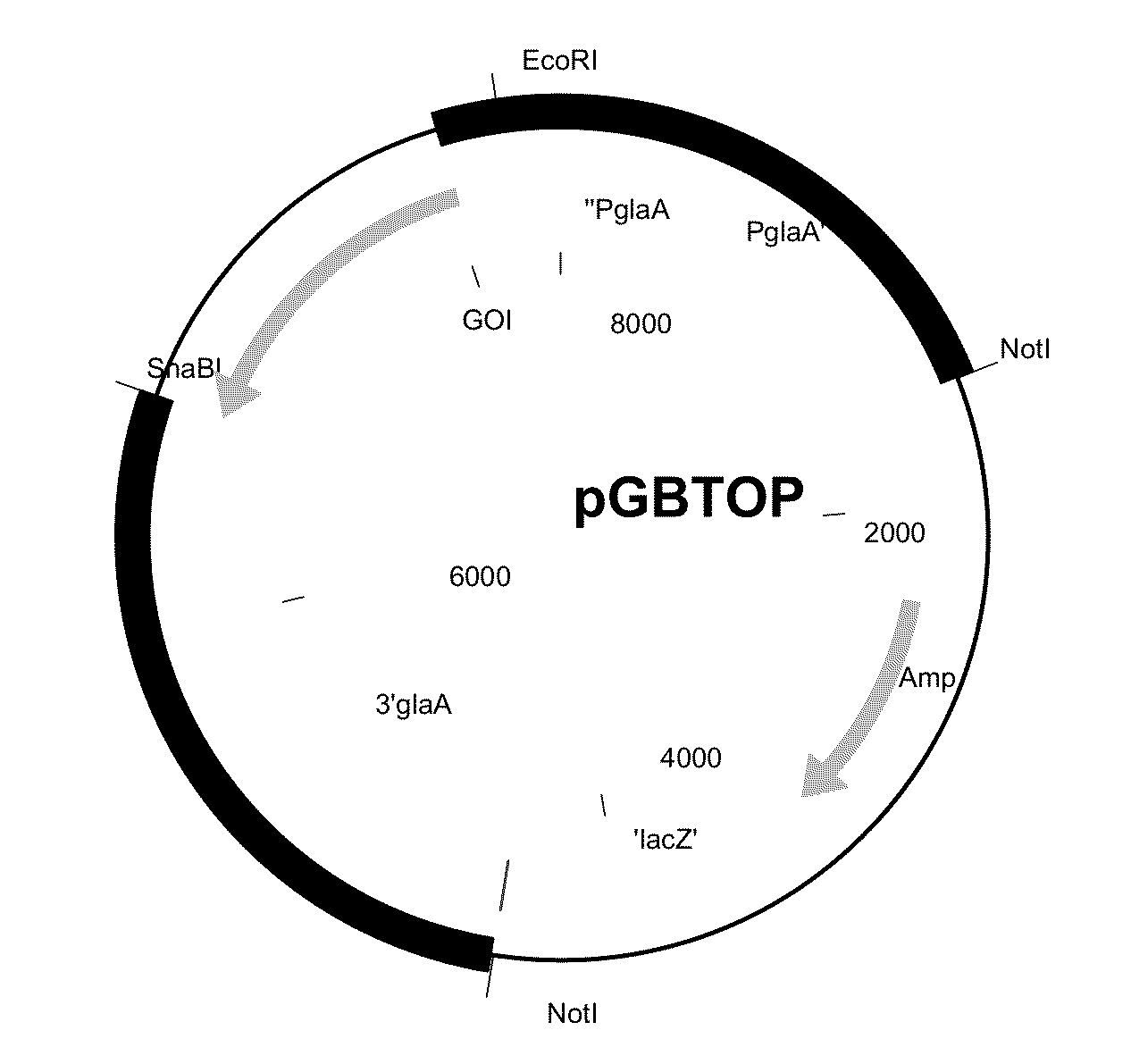Polypeptide having cellobiohydrolase activity and uses thereof
a polypeptide and hydrolase technology, applied in the field of polypeptides with cellobiohydrolase activity, can solve the problems of limiting the commercialization of biomass bioconversion processes, the energy potential of these carbohydrates is currently under-utilized, and the cost and hydrolysis efficiency of enzymes, so as to achieve high thermostability, high relative activity, and high tolerance to inhibitors
- Summary
- Abstract
- Description
- Claims
- Application Information
AI Technical Summary
Benefits of technology
Problems solved by technology
Method used
Image
Examples
example 1
1.1. Construction of Expression Plasmids
[0394]The sequence having SEQ ID NO: 1 was cloned into the pGBTOP vector (FIG. 1) using EcoRI and SnaBI sites, comprising the glucoamylase promoter and terminator sequence. The E. coli part was removed by NotI digestion prior to transformation of A. niger CBS 513.88.
1.2. Transformation of A. niger
[0395]A. niger WT-1: This A. niger strain is CBS513.88 comprising deletions of the genes encoding glucoamylase (glaA), fungal amylase and acid amylase. A. niger WT 1 is constructed by using the “MARKER-GENE FREE” approach as described in EP 0 635 574 B1.
[0396]The expression constructs are co-transformed to strain A. niger WT-1 according to the method described by Tilburn, J. et al. (1983) Gene 26, 205-221 and Kelly, J. & Hynes, M. (1985) EMBO J., 4, 475-479 with the following modifications:[0397]Spores are germinated and cultivated for 16 hours at 30 degrees Celsius in a shake flask placed in a rotary shaker at 300 rpm in Aspergillus minimal medium (...
example 2
Effect of CBH-II Polypeptide Supplementation in Wheat Straw Hydrolysis
[0405]A Talaromyces emersonii enzyme product, commercialised as Filtrase® NL, a product by DSM was used for hydrolysis of washed acid pretreated wheat straw (hereinafter abbreviated as PWS).
[0406]The enzyme doses applied for this classical product were 1 and 3 mg Bradford protein per g DM. Additionally, TEMER02270 was supplemented to a hydrolysis mixture containing 1 mg Bradford protein of Filtrase® NL per g dry mass PWS, at a concentration of 4.5 mg Bradford protein per g dry mass PWS. The extent of hydrolysis of the cellulose in the washed PWS was determined using a reducing sugar assay, as described above.
[0407]The degree of hydrolysis determined for Filtrase® NL, at 1 mg Bradford protein dose was 12%. Supplementation with 4.5 mg Bradford protein of the enzyme of Example 1 resulted in a degree of hydrolysis of 16.5%.
Method for Determination of Cellobiohydrolase II Activity
[0408]70 μL of enzyme solution was incu...
PUM
| Property | Measurement | Unit |
|---|---|---|
| temperatures | aaaaa | aaaaa |
| temperatures | aaaaa | aaaaa |
| temperatures | aaaaa | aaaaa |
Abstract
Description
Claims
Application Information
 Login to View More
Login to View More - R&D
- Intellectual Property
- Life Sciences
- Materials
- Tech Scout
- Unparalleled Data Quality
- Higher Quality Content
- 60% Fewer Hallucinations
Browse by: Latest US Patents, China's latest patents, Technical Efficacy Thesaurus, Application Domain, Technology Topic, Popular Technical Reports.
© 2025 PatSnap. All rights reserved.Legal|Privacy policy|Modern Slavery Act Transparency Statement|Sitemap|About US| Contact US: help@patsnap.com



